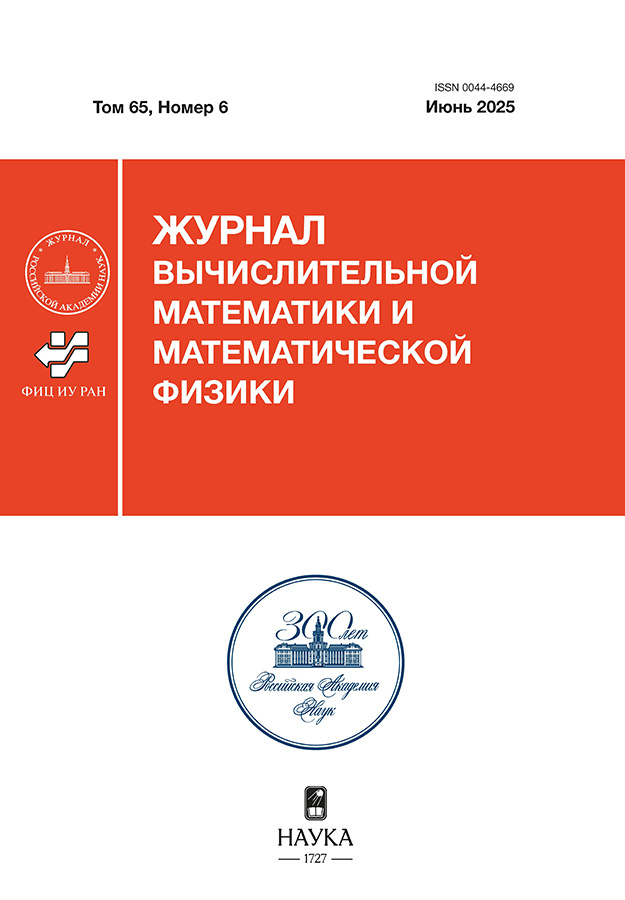DECOMPOSITION-COMPOSITION SCHEMES FOR SYSTEMS OF SECOND-ORDER EVOLUTIONARY EQUATIONS
- Авторлар: Vabishchevich P.N1,2
-
Мекемелер:
- Lomonosov Moscow State University
- M.K. Ammosov North-Eastern Federal University
- Шығарылым: Том 65, № 6 (2025)
- Беттер: 850-860
- Бөлім: General numerical methods
- URL: https://kazanmedjournal.ru/0044-4669/article/view/687777
- DOI: https://doi.org/10.31857/S0044466925060027
- EDN: https://elibrary.ru/IVEVIM
- ID: 687777
Дәйексөз келтіру
Аннотация
We consider numerical methods for approximate solution of the Cauchy problem for coupled systems of second-order evolution equations. Simplification of the problem at a new layer in time is achieved by separating simpler subproblems for the individual components of the solution. The computational technique of decomposition-composition consists of two steps. First, the decomposition of the operator matrix of the problem is performed, and then an approximate solution is constructed based on a linear composition of the solutions of the auxiliary problems. In this paper, we investigate decomposition variants based on the extraction of the diagonal part, lower and upper triangular submatrices of the operator matrix, as well as when splitting the operator matrix into rows and columns. Different variants of splitting schemes are used at the composition stage. In two-component decomposition, explicit-implicit schemes and factorized schemes are distinguished. Regularized additive schemes are used in multi-component splitting. The study of stability of three-layer decomposition-composition schemes is carried out on the basis of stability theory of operator-difference schemes in finite-dimensional Hilbert spaces.
Авторлар туралы
P. Vabishchevich
Lomonosov Moscow State University; M.K. Ammosov North-Eastern Federal University
Email: valv@cs.msu.ru
Moscow, Russia; Yakutsk, Russia
Әдебиет тізімі
- Knabner P., Angermann L. Numerical Methods for Elliptic and Parabolic Partial Differential Equations. Springer Verlag, 2003.
- Quarteroni A., Valli A. Numerical Approximation of Partial Differential Equations. Springer, 2008.
- Samarskii A.A. The Theory of Difference Schemes. New York: Marcel Dekker, 2001.
- Samarskii A.A., Matus P.P., Vabishchevich P.N. Difference Schemes with Operator Factors. Kluwer Acad. Publ., 2002.
- Ascher U.M. Numerical Methods for Evolutionary Differential Equations. Soc. for Industr. and Appl. Math., 2008.
- LeVeque R.J. Finite Difference Methods for Ordinary and Partial Differential Equations. Steady-State and Time-Dependent Problems. Soc. for Industr. and Appl. Math., 2007.
- Marchuk G.I. Splitting and alternating direction methods // Handbook of Numerical Analysis. V. I / Ed. by P.G. Ciarlet, J.L. Lions. North-Holland, 1990. P. 197–462.
- Vabishchevich P.N. Additive Operator-Difference Schemes: Splitting Schemes. Berlin, Boston: Walter de Gruyter GmbH, 2013.
- Vabishchevich P.N. Computational decomposition and composition technique for approximate solution of nonstationary problems // J. Comput. and Appl. Math. 2024. V. 451. № 116111. P. 1–18.
- Ascher U.M., Ruuth S.J., Wetton B.T.R. Implicit-explicit methods for time-dependent partial differential equations // SIAM J. Numeric. Analys. 1995. V. 32. № 3. P. 797–823.
- Hundsdorfer W.H., Verwer J.G. Numerical Solution of Time-Dependent Advection-Diffusion-Reaction Equations. Springer Verlag, 2003.
- Vabishchevich P.N. Explicit-Implicit Schemes for First-Order Evolution Equations // Differ. Equat. 2020. V. 56. № 7. P. 882–889.
- Vabishchevich Petr N. Decoupling technology for systems of evolutionary equations // Computers and Mathematics with Applications. 2025. V. 191. P. 105–128.
- Saad Y. Iterative Methods for Sparse Linear Systems. SIAM, 2003.
- Samarskii A.A., Vabishchevich P.N., Gulin A.V. Stability of operator-difference schemes // Differ. Uravn. 1999. V. 35. № 2. P. 152–187. in Russian.
- Samarskii A.A., Vabishchevich P.N. Regularized additive full approximation schemes // Dokl. Akad. Nauk. 1998. V. 358. P. 461–464. in Russian.
Қосымша файлдар









